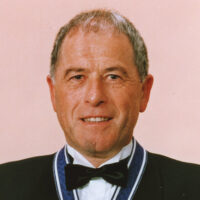
1998 Kyoto Prize Laureates
Biotechnology and Medical Technology
/ Structural Biologist
1938 -
Professor, Molecular Biophysics and Chairman, Department of Biology, Swiss Federal Institute of Technology (ETH)
From Nature to Natural Science
1998
11 /11 Wed
Place:Kyoto International Conference Center
NMR in Structural Biology-History and Perspectives
1998
11 /12 Thu
13:00 - 17:30
Place:Kyoto International Conference Center
Expanding the conventional nuclear magnetic resonance (NMR) technique, Dr. Wüthrich developed a method of determining the conformations of proteins, nucleic acids and other biomacromolecules as such in solutions or biomembranes, where they exhibit their function. This achievement made an unprecedented contribution to structural and molecular biology, representing a great advance in biotechnology.
Expanding the conventional nuclear magnetic resonance (NMR) technique, Dr. Wüthrich developed a method of determining the conformations of proteins, nucleic acids and other biomacromolecules as such in solutions or biomembranes, where they exhibit their function. This achievement made an unprecedented contribution to the advance in structural and molecular biology.
Traditionally, structural biology had relied largely on X-ray crystallography, in which biomacromolecules are analyzed after crystallization; however, the conventional technique cannot analyze non-crystallizable substances, nor does it permit conformation analysis in solutions, where biomacromolecules exhibit their biological activity. Dr. Wüthrich developed a new technique for atomic-level determination of protein structures in solution, based on distance geometry, a unique idea for building conformations using atom-to-atom distance information based on the Nuclear Overhauser Effect (NOE) resulting from electron-nucleus interaction induced by nuclear magnetic resonance (NMR). This new technique is a result of multidisciplinary achievements, including new determination and analytical methods, computer-aided structural determination algorithms, and sophisticated graphic tools, and could not be realized without Dr. Wüthrich’s excellent talent for research. As many as 1,200 protein conformations have been determined by his NMR technique, accounting for one-fifth of the protein conformations that have been resolved to date.
Using the technique, he himself has determined the conformations of a wide variety of biologically important biomacromolecules, including DNA-binding proteins, pharmacologically active neuropeptides and cytokines. The recent determination of conformations of the prion protein, which is associated with bovine spongiform encephalopathy, and of the cyclosporin A-cyclophilin complex, which plays a significant role in immunosuppression, in particular, serves as a good example of the technique’s successful application in biology and medicine.
Besides his achievement in the development of the conformation determination technique, Dr. Wüthrich developed a technique for directly observing protein molecule movement and quantifying protein mobility. While conventional crystallography provides static data on proteins, the NMR method provides dynamic profiles of proteins in action on various time scales in aqueous solutions. The protein mobility thus observed represents new data on protein profiles, showing close correlation with enzyme activity and molecule recognition. This achievement has ensured access to very useful information for the functional analysis of new biomolecules, and has had major impact on the applications to protein engineering, such as drug design, thus making significant contributions to biotechnology.
In short, Dr. Wüthrich has established a new methodology for structural biology, a field of research into structure-function correlation in proteins and other biomolecules, and has made a breakthrough leading to elucidation of the mechanisms of complex biological phenomena, significantly contributing thereby to the advance in structural and molecular biology. For these reasons, the Inamori Foundation is pleased to bestow upon Dr. Wüthrich the 1998 Kyoto Prize in Advanced Technology.
Profile is at the time of the award.